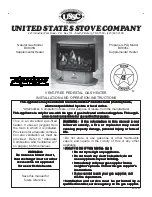
39
E. Water Quality
1. The water directly in contact with the appliance
must meet the requirements in
. Failure to
adhere to the water treatment requirements in this
manual can cause damage not covered by warranty
to the appliance, pumps, or other components in
the system.
2. It will be necessary to gain knowledge of the
impurities dissolved in the water and consult with
a qualified industrial water treatment professional
to establish a treatment plan. In addition, a periodic
testing/sampling plan should be developed.
3.
To minimize corrosion and scale effects, adhere to
the water quality requirements in
.
a.
If the water hardness is higher than 205 ppm (12
gpg), a water softener must be used.
b.
Water with a hardness of less than 80 ppm (5 gpg)
can have a pH level that is corrosive.
4.
Total Dissolved Solids (TDS) contribute to scale
buildup. If the TDS or combined water hardness
and TDS exceeds 450 ppm, the water needs to be
heated indirectly.
a.
The TDS (in ppm) is determined by measuring the
electrical conductivity (µS/cm) of the water and
multiplying by a conversion factor (typically 0.65
for drinking water).
5. Chlorine and Chloride can be very corrosive to
stainless steel. Ensure the level of chlorine is less
than 5 ppm and the level of chloride is less than
1000 ppm.
a. The BFIT is
not
designed for the heating of
swimming pool water.
6.
Before connecting the appliance, insure the system
is free of impurities, grease, sediment, construction
dust, and any other contaminants.
. Water Piping
(continued)
BFIT Model Max Flow
(GPM)
Min Flow
(GPM)
1000
450
35
1250
44
1500
53
2000
600
71
NOTICE:
This table represents the
absolute max and min flow rates allowed
and shall
not
be used to design the system
or size the circulator.
Flow Rate (GPM)
BFIT
Model
Hardness level,
4-12 gpg
Hardness level,
12-15 gpg
1000
99
132
1250
99
132
1500
110
147
2000
138
183
If system contains aluminum components, pH must
be less than 8.5.
NOTICE
NOTICE
Water temperatures over 140 °F (60 °C) greatly
increase the affects of corrosive chemicals.
Chlorine and Chloride have different levels of
corrosion effects on stainless steel. It is recom
-
mended for chlorine (Cl2)
levels to be below 5ppm
and chloride (Cl
-
)
levels to be below 1000 ppm for
316 stainless steel.
Quality Parameter
Minimum
Maximum
Water Hardness (ppm)
80
205
Total Dissolved Solids (ppm)
100
450
Chlorine (ppm)
-
5
Chloride (ppm)
-
1000
pH (cold)
6.5
7.5
Notes:
The combined water hardness and TDS cannot exceed
450 ppm.
1 grain per gallon = 17.1 ppm
Table 22: Water Quality Requirements
a.
Flush the system thoroughly and repeatedly, if
needed.
Table 23: Operating Water Flow Rates
Table 24: Absolute Water Flow Rates
















































